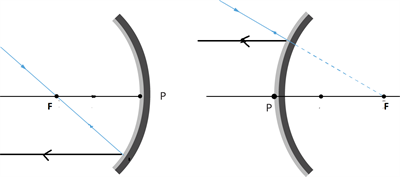
PUMPA - SMART LEARNING
எங்கள் ஆசிரியர்களுடன் 1-ஆன்-1 ஆலோசனை நேரத்தைப் பெறுங்கள். டாப்பர் ஆவதற்கு நாங்கள் பயிற்சி அளிப்போம்
Book Free DemoRay diagrams help in the study of the formation of images by spherical mirrors.
Consider a finite-size extended object in front of a spherical mirror.
A point source is a small portion of the extended object that acts as a source of light. Each of these points emits an infinite number of rays.
To locate the position of the image, an arbitrarily large number of rays emanating from a point could be considered when constructing the ray diagrams.
However, for clarity in the ray diagram, it is more convenient to consider only two rays. These rays are chosen so that their directions are easily discernible after reflection in the mirror. The position of the image of the point object is determined by the intersection of at least two reflected rays.
(i) A ray parallel to the principal axis, after reflection, will pass through the principal focus in the case of a concave mirror or appear to diverge from the principal focus in the case of a convex mirror.

(ii) A ray passing through the principal focus of a concave mirror or a ray that is directed towards the principal focus of a convex mirror, after reflection, will emerge parallel to the principal axis.

(iii) A ray passing through the centre of curvature of a concave mirror or directed in the direction of the centre of curvature of a convex mirror, after reflection, is reflected back along the same path.
The light rays come back along the same path because the incident rays fall on the mirror along the normal to the reflecting surface.

(iv) A ray incident obliquely to the principal axis, towards a point \(P\) (pole of the mirror), on the concave mirror, is reflected obliquely. The incident and reflected rays follow the laws of reflection at the point of incidence (point P), making equal angles with the principal axis.

Remember that the laws of reflection are followed in all of the above cases. The incident ray is reflected at the point of incidence in such a way that the angle of reflection equals the angle of incidence.